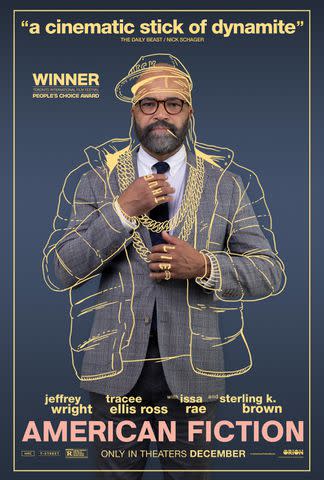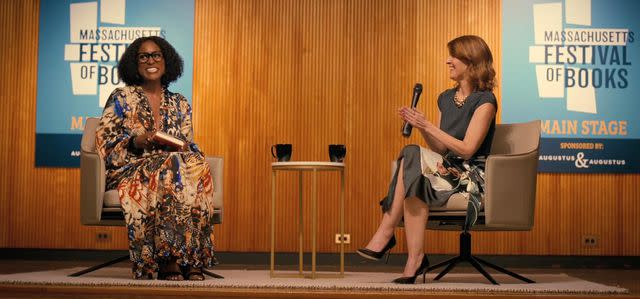“American Fiction”: The Biggest Changes Between the Book “Erasure” and New Movie Starring Jeffrey Wright
- Oops!Something went wrong.Please try again later.
- Oops!Something went wrong.Please try again later.
- Oops!Something went wrong.Please try again later.
‘American Fiction,’ which stars Jeffrey Wright, is based on Percival Everett’s 2001 novel ‘Erasure’

Claire Folger
Director Cord Jefferson’s feature film directorial debut, American Fiction, is a movie not to miss.
The film follows Thelonious “Monk” Ellison (Jeffrey Wright), a Black writer who is frustrated his books don’t sell while books filled with racial stereotypes do. He decides to write a novel under the pen name Stagg R. Leigh called My Pafology, its title later changed, that parodies the books he sees garnering attention.
When the novel becomes a huge success, Monk finds himself caught up in a web of lies that may have dire consequences.
The film also stars Sterling K. Brown, Issa Rae, Erika Alexander, Tracee Ellis Ross and Leslie Uggams.
It's based on Percival Everett’s 2001 novel titled Erasure. While both the book and movie present a satirical look at the experiences of marginalized authors within the publishing industry, there are some major differences from page to screen.
Read on for some of the biggest differences.
Warning: Major spoilers for American Fiction and Erasure
The movie is set in the greater Boston area, not D.C.

Orion Pictures
While Erasure largely takes place in Washington, D.C., where Monk grew up, the movie’s setting has been changed to Boston. The family has a vacation home in a coastal town, whereas the novel saw Monk’s family vacations in a bungalow in Maryland.
Monk’s father’s affair is explored in more detail in the novel
Both the novel and movie touch upon Monk’s late father’s infidelity to his wife Agnes (Leslie Uggams). The movie has taken some liberties with the cheating scandal, such as having Monk’s sister Lisa find out about their father’s affair instead of Monk. Additionally, the novel explores the affair more in-depth and includes letters from Monk’s father’s lover, Fiona. Also cut from the movie is Monk’s half-sister Gretchen, whom Monk eventually tracks down.
Related: Jeffrey Wright Plays an Author Who Unwittingly Writes a Hit in American Fiction Trailer
Monk’s sister Lisa dies under different circumstances
Monk’s sister Lisa is a recent divorcee who doesn’t quite understand her brother’s books. One of the biggest changes regarding her character is how she dies early on in the story. In the movie, Lisa dies from a sudden heart attack while at a restaurant with Monk. In the novel, she is shot and killed when someone fires a gun through the windows of the women’s health clinic where she works.
Monk’s girlfriend has a new name

Claire Folger
Monk’s love interest Coraline (Erika Alexander) is Monk’s neighbor at his family’s vacation house. In the movie, Coraline is a lawyer who is just getting out of a relationship and supports Monk as he moves his mother into a care facility. In the novel, Coraline’s character is originally called Marilyn Tilman. Her uncle lived across the street from Monk’s family at their vacation home in Maryland.
Stagg R. Leigh’s complete novel is not explored
Erasure includes the whole text for Stagg R. Leigh’s novel My Pafology (later titled F–-k) within the novel itself. While the whole book is understandably not explored in the movie, it does include a scene of Monk writing the book while two characters that appear in My Pafology, protagonist Van Go Jenkins (Okieriete Onaodowan) and Willy (Keith David), act out a scene as Monk writes it.
Related: The Biggest Differences Between the Leave the World Behind Book and Movie
Stagg R. Leigh is a wanted fugitive
When creating his pseudonym Stagg R. Leigh, Monk and his agent Arthur (John Ortiz) tell the book’s publisher that Stagg is a wanted fugitive. This backstory causes issues for Monk throughout the movie, as the FBI calls the book’s publishing house to try and find out his identity. In the novel, Stagg has only been to prison and is not on the run.
Sintara Golden is a judge on the Literary Award panel

ORION Pictures
In both versions of the story, Monk serves as a judge for a book award (named the Book Award in the novel and the Literary Award in the movie). In the movie, he is also joined by Black author Sintara Golden (Issa Rae), the author of the fictional novel We’s Lives In Da Ghetto, which Monk thinks is filled with stereotypes. Other liberties have been taken with Sintara’s character as well, such as her name. (In Erasure, the author’s original name is Juanita Mae Jenkins.)
Coraline reads Stagg R. Leigh’s novel instead of Sintara’s
One plot point that hinders Monk’s relationship in both versions of the story is when Monk finds out his girlfriend is reading a book that he finds problematic. The book she reads, however, differs. In the movie, Coraline is reading F–-k, which incites an argument between the couple, resulting in Monk walking out. In the novel, Marilyn is reading Juanita Mae Jenkins’ book instead.
The ending of the movie is different than the book (kind of)
While Erasure wraps up on an ambiguous cliffhanger, with Monk going up onstage at the Book Award ceremony, the movie offers several alternate endings. It’s revealed that the whole movie turns out to be a film that Monk is developing with a man named Wiley (Adam Brody). The two develop different endings to the movie in real time, including one where Monk leaves the ceremony to make amends with Coraline, and another where the FBI come to arrest Stagg and kill Monk while he’s onstage. Wiley agrees this is the ending that works best, and American Fiction ends with Monk leaving the movie set with his brother Cliff (Sterling K. Brown).
For more People news, make sure to sign up for our newsletter!
Read the original article on People.

